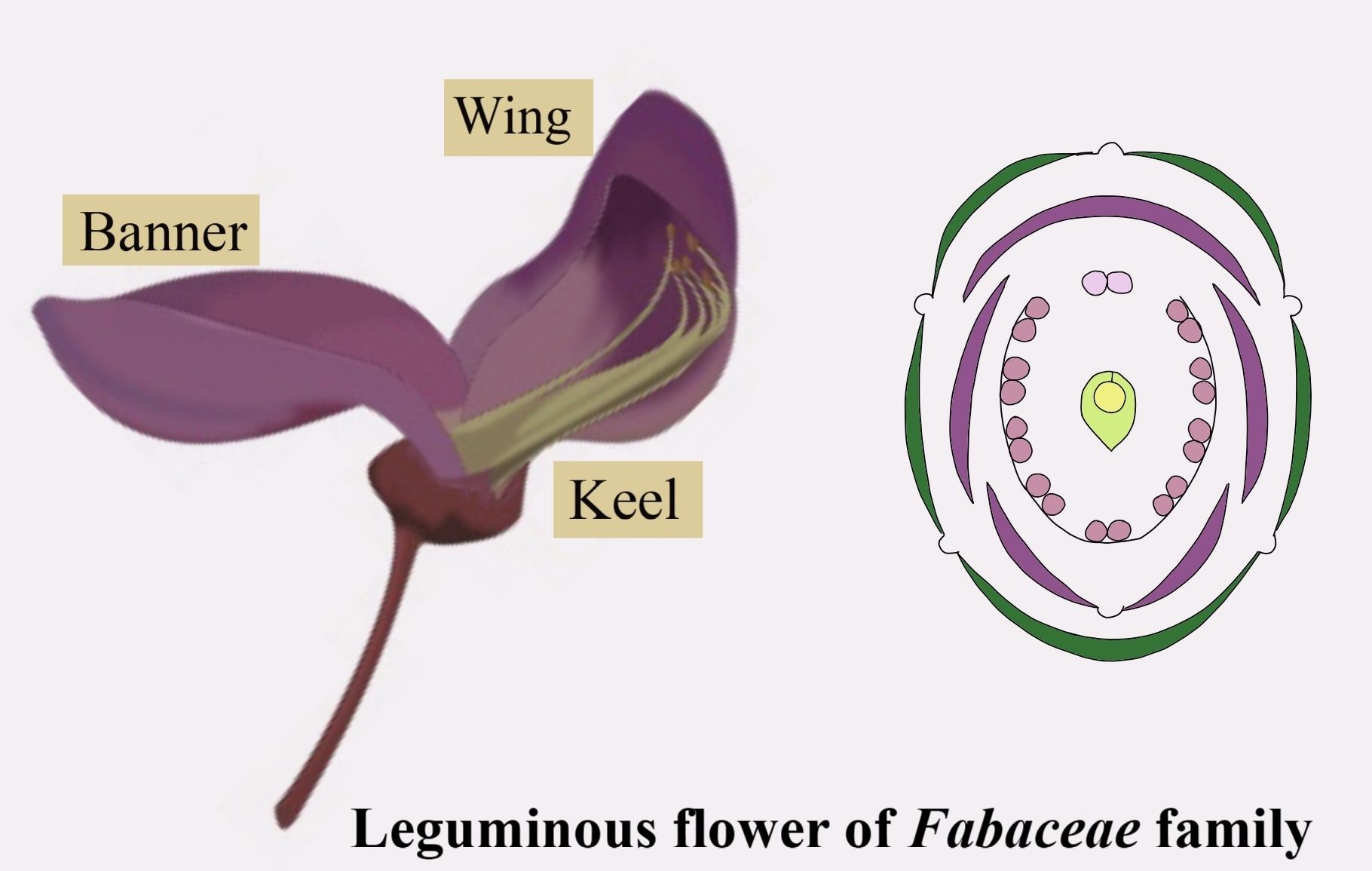
A diagnostic trait for the identification of fabaceous flowers is
A)Tetradynamous androecium
B)Inferior ovary
C)Cruciform Corolla
D)Vexillary aestivation
Answer
471.3k+ views
Hint: The legume, pea, or bean family comes under the Fabaceae or Leguminosae. This family is a very economically important group of flowering plants. It includes all perennial or annual herbaceous plants. It bears a unique arrangement of flowers where the small petals are mostly covered by large petals.
Complete answer:
Floral Characters of Fabaceae plant
Inflorescence: Racemose.
Flower: Complete, bisexual, zygomorphic, hypogynous, bracteate/ ebracteate.
Calyx: Five sepals, gamosepalous; valvate or imbricate aestivation.
Corolla: Five petals, polypetalous, papilionaceous, vexillary aestivation.
Androecium: consists of Ten stamens (9+1), stamens United by their filaments (diadelphous), and anther is dithecous.
Gynoecium: ovary is superior, consist of the single carpel (monocarpellary), characterized by only one locular or cavity (unilocular), and have a hairy stigma
Fruit: mostly Legume.
Seed: One or more, non-endospermic.
-So, the main characteristic of the Fabaceae family is the Vexillary or descending imbricate aestivation. In Vexillary aestivation the posterior largest petals cover a lateral petal known as wings which in turn overlap two anterior petals known as the keel. It is also known as the papilionaceous corolla.

Additional Information:
Vegetative Characters of fabaceae plant
Root: Dicotyledons, taproot with root nodules.
Stem: mostly erect and are a climber. It includes shrubs, herbs trees and climbers.
Leaves: are petiolate, have pinnately compound or simple leaves, the base of the leaf is pulvinus, leaves are stipulated and have reticulate venation.
-Tetradynamous androecium - mostly found in Brassicaceae plants and can be seen in mustard (scientific name is brassica campestris). It consists of six stamens in which the outer two are shorter and the inner four are longer.
-Cruciform corolla - are polypetalous Corolla. It consists of four free petals which are equal in size and they are arranged in the form of a cross. This type of corolla is a characteristic of the family Brassicaceae. Can be seen in radish.
-Inferior ovary -ovary is attached and present below the petal, sepals, and stamens. An Apple or cherry plant has an inferior ovary because their ovary is fused with a thick fleshy hypanthium.
So, the correct answer is,” Vexillary aestivation”.
Note: -Arrangement of the floral parts of a flower inside a bird until it blooms into a flower is known as aestivation.
-In Vexillary aestivation smaller petals are covered by larger petals.
-The larger petal is called a vexillum, while the two curved petals which are laterally positioned are called wings. The two innermost, boat-shaped petals are called keels.
Examples: Polypetalous, papilionaceous
-Fabaceous plants bear fruits (legumes) and comprise the compound and stipulated leaves.
Complete answer:
Floral Characters of Fabaceae plant
Inflorescence: Racemose.
Flower: Complete, bisexual, zygomorphic, hypogynous, bracteate/ ebracteate.
Calyx: Five sepals, gamosepalous; valvate or imbricate aestivation.
Corolla: Five petals, polypetalous, papilionaceous, vexillary aestivation.
Androecium: consists of Ten stamens (9+1), stamens United by their filaments (diadelphous), and anther is dithecous.
Gynoecium: ovary is superior, consist of the single carpel (monocarpellary), characterized by only one locular or cavity (unilocular), and have a hairy stigma
Fruit: mostly Legume.
Seed: One or more, non-endospermic.
-So, the main characteristic of the Fabaceae family is the Vexillary or descending imbricate aestivation. In Vexillary aestivation the posterior largest petals cover a lateral petal known as wings which in turn overlap two anterior petals known as the keel. It is also known as the papilionaceous corolla.

Additional Information:
Vegetative Characters of fabaceae plant
Root: Dicotyledons, taproot with root nodules.
Stem: mostly erect and are a climber. It includes shrubs, herbs trees and climbers.
Leaves: are petiolate, have pinnately compound or simple leaves, the base of the leaf is pulvinus, leaves are stipulated and have reticulate venation.
-Tetradynamous androecium - mostly found in Brassicaceae plants and can be seen in mustard (scientific name is brassica campestris). It consists of six stamens in which the outer two are shorter and the inner four are longer.
-Cruciform corolla - are polypetalous Corolla. It consists of four free petals which are equal in size and they are arranged in the form of a cross. This type of corolla is a characteristic of the family Brassicaceae. Can be seen in radish.
-Inferior ovary -ovary is attached and present below the petal, sepals, and stamens. An Apple or cherry plant has an inferior ovary because their ovary is fused with a thick fleshy hypanthium.
So, the correct answer is,” Vexillary aestivation”.
Note: -Arrangement of the floral parts of a flower inside a bird until it blooms into a flower is known as aestivation.
-In Vexillary aestivation smaller petals are covered by larger petals.
-The larger petal is called a vexillum, while the two curved petals which are laterally positioned are called wings. The two innermost, boat-shaped petals are called keels.
Examples: Polypetalous, papilionaceous
-Fabaceous plants bear fruits (legumes) and comprise the compound and stipulated leaves.
Recently Updated Pages
The correct geometry and hybridization for XeF4 are class 11 chemistry CBSE

Water softening by Clarks process uses ACalcium bicarbonate class 11 chemistry CBSE

With reference to graphite and diamond which of the class 11 chemistry CBSE

A certain household has consumed 250 units of energy class 11 physics CBSE

The lightest metal known is A beryllium B lithium C class 11 chemistry CBSE

What is the formula mass of the iodine molecule class 11 chemistry CBSE

Trending doubts
Why was the Vernacular Press Act passed by British class 11 social science CBSE

Arrange Water ethanol and phenol in increasing order class 11 chemistry CBSE

Name the nuclear plant located in Uttar Pradesh class 11 social science CBSE

One Metric ton is equal to kg A 10000 B 1000 C 100 class 11 physics CBSE

What steps did the French revolutionaries take to create class 11 social science CBSE

How did silk routes link the world Explain with three class 11 social science CBSE




